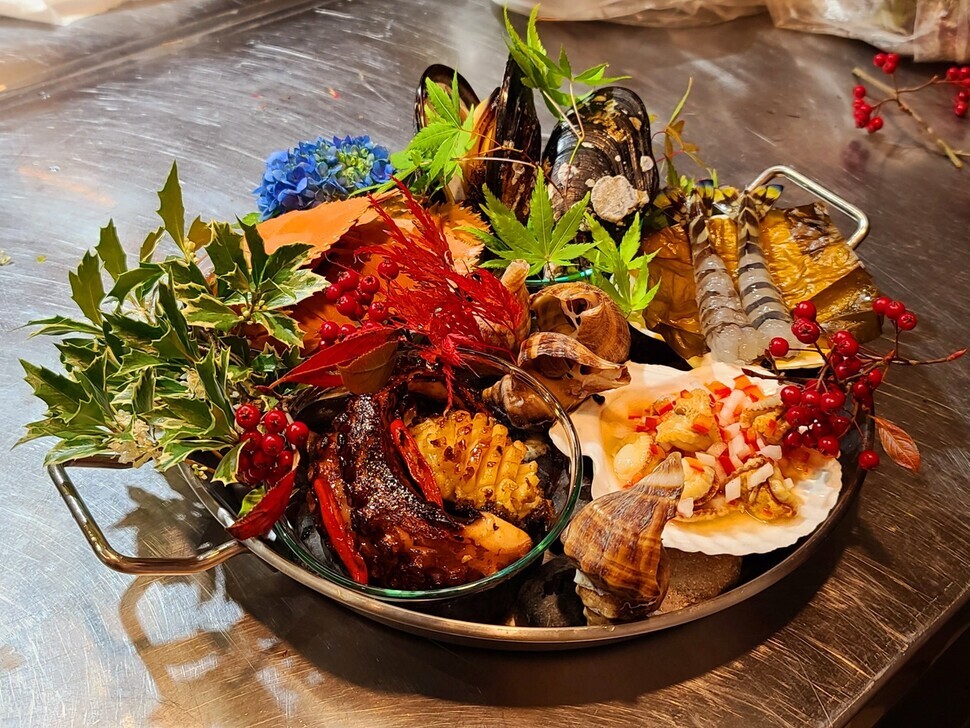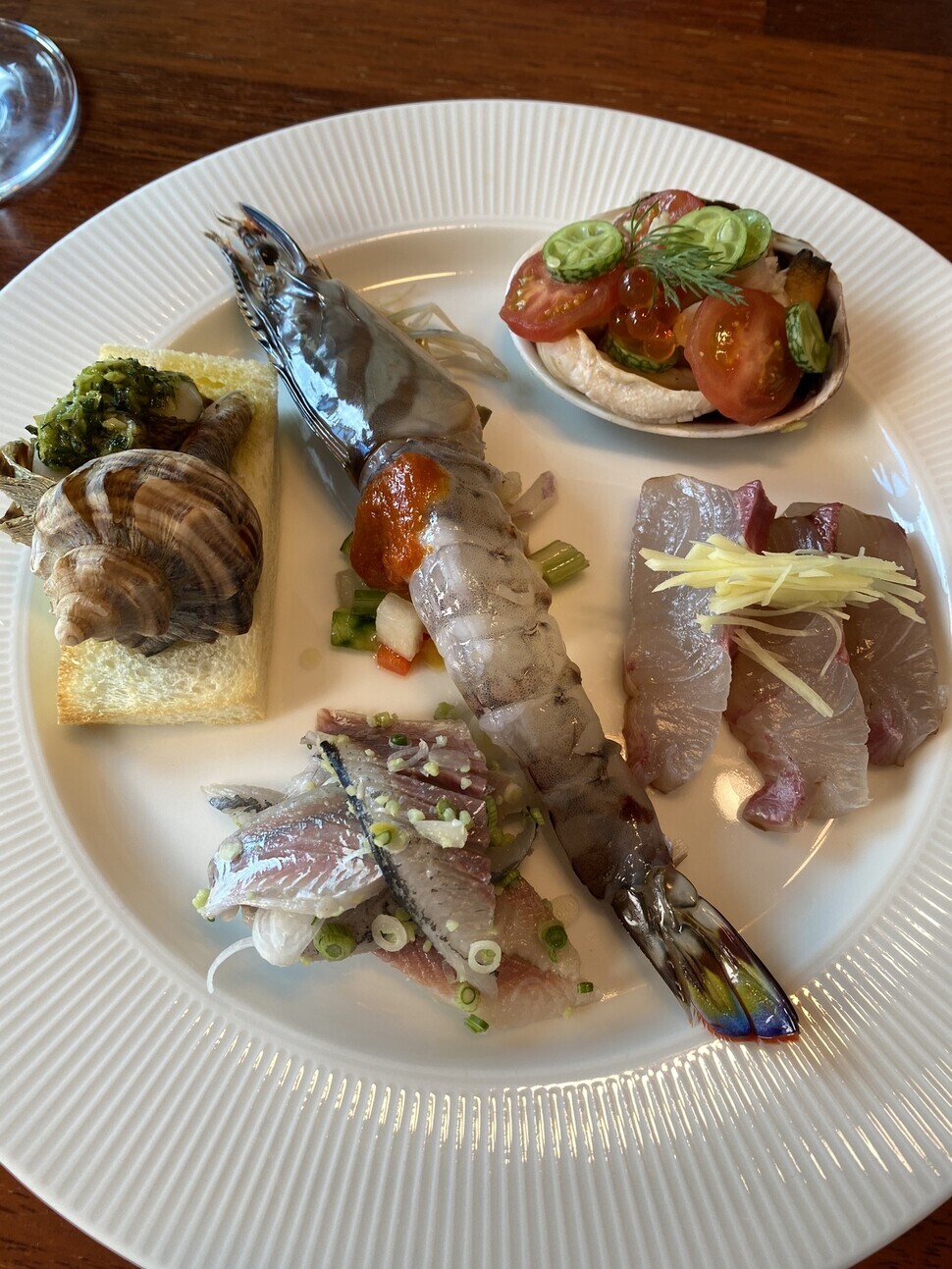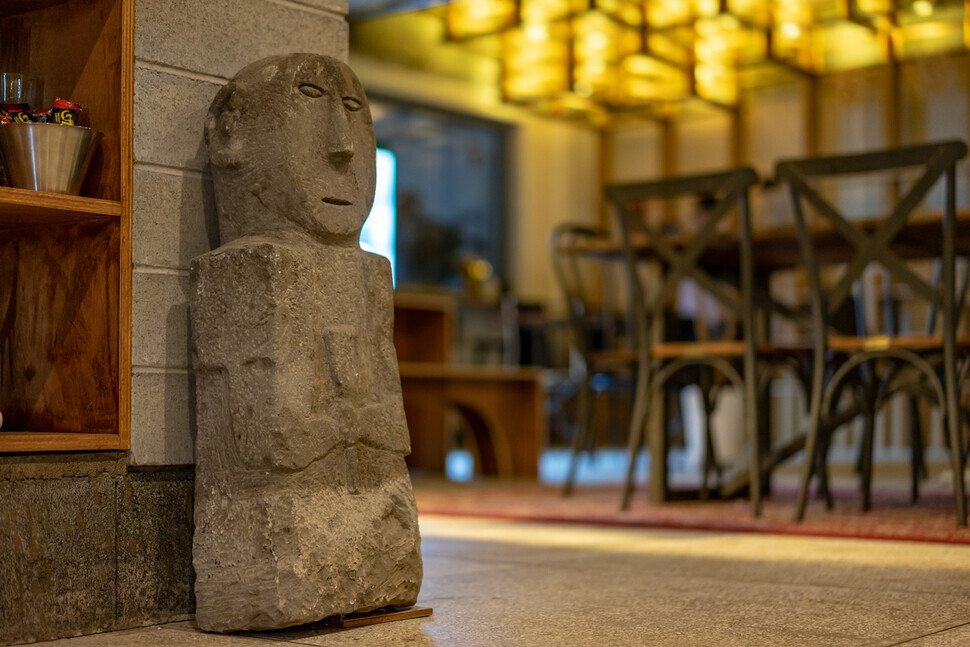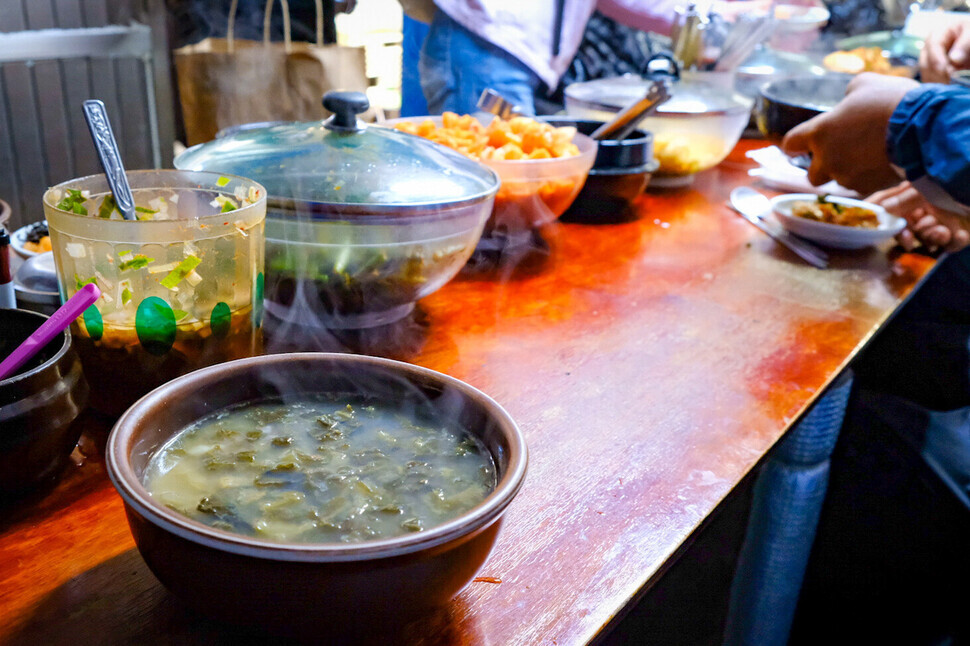hankyoreh
Links to other country sites 다른 나라 사이트 링크
[Korea travels] Just bring your appetite, Tongyeong will provide the rest

Out of sight, out of mind. The familiar proverb certainly has a ring of truth to it. Perhaps it’s built into human nature that once something’s physically far enough not to see it, it’s easy to not think about it.
The principle holds true for things other than people as well. When you know the things that are always around or a place you can go to at any time, a distant city or unfamiliar area can feel lightyears away. As a Seoul native, the city of Tongyeong felt like such a place for me.
Tongyeong’s claim to fame comes from a few sources: having been the backdrop of the movie “Hahaha” by famed director Hong Sang-soo, for being the city of chungmu kimbap, and its seaside hills that earned it the name “Naples of the East.”
There are many fancy nicknames for this city, but the real reason to go to Tongyeong right now is that the chill of winter still lingers over the harbors. Though the stars say that spring started on Feb. 4, the cool breeze coming in off the ocean assures you that spring has yet to come, meaning that there’s still time to taste the extraordinary food that the cold months have to offer.

On Feb. 1, I jumped on an express bus to visit Tongyeong before missing the end of winter. Since it’s famous for its oysters, tourists who visit the city in the winter are often there singularly for the bivalves. Besides many other kinds of seafood, the city has other regional specialties such as honey bread (kkulppang) and chungmu kimbap. But there’s more to what the coastal city has to offer.
While simple and local food is good, if you dive deeper into learning more about the city, you quickly learn that it’s also a city of romance and gastronomy.
For example, the Tongyeong International Music Festival, also called the “Salzburg Festival of Asia,” is held in the city every year. Besides this, the city also offers visitors many options for stylish dining places, making it a romantic destination as well.
One of the places that have recently popped up as a gourmet restaurant in Tongyeong is called Yasojuban. While many reviews of the restaurant have already been posted online, it’s premature to judge this place based solely on such reviews. The restaurant only accepts diners through reservations and thoughtfully serves food made with fresh ingredients prepared the same day as chosen by the owner.
The restaurant is located in a remote place in the city’s Sanyang neighborhood, which used to be called Yasogol in the past. It is not an easy place to find, and the prices aren’t cheap either, even compared to fine-dining restaurants in Seoul.
Still, there are definitely reasons to visit this restaurant.

When you arrive, you enter a small house where the owner and his family actually live. A garden full of flowers welcomes guests regardless of the season. Despite being born and raised in Seoul, I felt like I was coming back home.
This is when the special experience begins at this restaurant. The first room upon entering the house is a quiet tearoom and dining room for visitors. While you can’t go wrong with their wine or beer selection, the alcohol that pairs best with this restaurant’s delicate food is their own homemade makgeolli.
“Makgeolli brewed by an architect” is a masterpiece that architect Park Jun-woo, husband of Yasojuban owner Kim Eun-ha, put his heart and soul into in Yasogol.
“It’s a pity to only drink white wine or soju with Tongyeong’s seafood,” Park said, explaining why he started brewing makgeolli himself.
The delicate scent of peaches and crisp yet pleasant acidity pair well with raw foods such as raw oysters and sashimi, cod filets, and ceviche drizzled with olive oil.

But Korean food isn’t all that you’ll find in Tongyeong. O’wall in downtown Tongyeong’s Donam neighborhood is one option if you’re looking for something French or Italian. Owner and chef Kim Hyeon-jeong says the restaurant has kept its name since it originally first opened in Seoul’s Buam neighborhood in 2008 before moving to Tongyeong.
But nothing good comes easy: O’wall requires a bit of navigating to get to and you’ll need a reservation before visiting.
But the reason why this place is worth going to despite the inconveniences is because of the taste of the food. It is rare one gets the special opportunity to taste fresh, local ingredients prepared with the proper care in a delicious way.
Simple dishes requiring little actual cooking such as sashimi and grilled clams are very common in towns by the sea. While these foods also have their own unique taste, the chef at this restaurant adds her own twist to the fresh ingredients that she chooses every day.
Right off the bat, the first course is already pleasing to both the eyes and mouth. It’s the eatery’s signature dish: four to five small dishes on a single plate. The small bites are similar to tapas and have toppings consisting of seafood, fruits, and cheeses that fit with that particular season.
The menu is full of foods that stick to the mouth, such as octopus gambas, mascarpone cheese, and puree made of pollack roe. It is definitely worth experiencing the feeling of being given first-class treatment at a friend’s house or, when visiting during the day, experiencing the feeling of swallowing the Tongyeong sea together with the warm southern sunlight.

After enjoying such a special meal to the fullest, it’s time for a night out in the city. After all, Tongyeong is famous for its “dazzi” pubs. Dazzi, a name given to Tongyeong’s own unique drinking culture, refers to how pub owners serve alcohol along with side dishes made with fresh ingredients from that day.
This is also sometimes called “imokase” which is a combination of the Korean word “imo” (aunt) and the Japanese word “omakase” (dining experience where the chef decides what is served). This is a system that is optimized for those who enjoy a night out drinking: customers pay the basic food price per person and every time an additional round of drinks is ordered, a food pairing comes with it.
Ssahinjeong, located in the city’s Hangnam neighborhood, not only has a unique name but also an unusual appearance. There’s only a very small sign hanging in front of the place. The pub is located in an obscure alley and is very remote, in an area where many would wonder if there would even be a bar there.
But there is, and reservations are required in order to visit since fresh ingredients are bought from the market every day to make the dishes.
Alcohol and side dishes are served for 50,000 won (US$38) per person for every additional 10,000 won worth of alcohol that is purchased, one plate of food is added. The first things that caught my eye were the sweet, seasoned spinach and soy sauce marinated crab appetizers.
This was then followed up by fresh seafood such as sea squirt sashimi, fermented sea cucumber viscera, and cuttlefish. Cold soju and beer are taken out from cold ice boxes like they used to serve at old, tented bars on the streets. With all that alcohol, you may end up three sheets to the wind.

Now that you’ve had food and alcohol to your heart’s content, now it’s time to cleanse your tired body of the briny sea breeze and all that alcohol. The charm of Mireuk Mireuk Beer Hostel comes from not knowing what kind of a place it could possibly be.
A pub is on the first floor, a guest house is on the second, and a large living room in which you can practice yoga and meditate, as well as a small library, is on the third floor.
As per the words of the CEO, Kim Hyeong-seok, “Cleanliness is the life of Mireuk Mireuk,” so tired guests are greeted with clean towels and paper-white bedding that is cleaned daily, and welcomed with a glass of beer. The pub on the first floor manages to be both lively and relaxing, which can be attributed to the various meditation spaces in the area.
As a hostel named after Tongyeong’s famous attractions Mireuk Island and Mount Mireuk, various Maitreya logos adorn the accommodation. Despite being surrounded by all these Buddhas, CEO Kim is a devout Catholic.
“All I want is that everyone who visits manages to find peace of mind, so it isn’t as if any of this is religious,” he said with a smile.
Despite its queerness, it is a place where you can drink craft beer produced across Korea.
By Baek Mun-yeong, food and travel writer
Please direct questions or comments to [english@hani.co.kr]

Editorial・opinion
![[Editorial] Yoon must halt procurement of SM-3 interceptor missiles [Editorial] Yoon must halt procurement of SM-3 interceptor missiles](https://flexible.img.hani.co.kr/flexible/normal/500/300/imgdb/child/2024/0501/17145495551605_1717145495195344.jpg) [Editorial] Yoon must halt procurement of SM-3 interceptor missiles
[Editorial] Yoon must halt procurement of SM-3 interceptor missiles![[Guest essay] Maybe Korea’s rapid population decline is an opportunity, not a crisis [Guest essay] Maybe Korea’s rapid population decline is an opportunity, not a crisis](https://flexible.img.hani.co.kr/flexible/normal/500/300/imgdb/original/2024/0430/9417144634983596.jpg) [Guest essay] Maybe Korea’s rapid population decline is an opportunity, not a crisis
[Guest essay] Maybe Korea’s rapid population decline is an opportunity, not a crisis- [Column] Can Yoon steer diplomacy with Russia, China back on track?
- [Column] Season 2 of special prosecutor probe may be coming to Korea soon
- [Column] Park Geun-hye déjà vu in Yoon Suk-yeol
- [Editorial] New weight of N. Korea’s nuclear threats makes dialogue all the more urgent
- [Guest essay] The real reason Korea’s new right wants to dub Rhee a founding father
- [Column] ‘Choson’: Is it time we start referring to N. Korea in its own terms?
- [Editorial] Japan’s rewriting of history with Korea has gone too far
- [Column] The president’s questionable capacity for dialogue
Most viewed articles
- 1Months and months of overdue wages are pushing migrant workers in Korea into debt
- 2[Editorial] Yoon must halt procurement of SM-3 interceptor missiles
- 3Trump asks why US would defend Korea, hints at hiking Seoul’s defense cost burden
- 4[Guest essay] Maybe Korea’s rapid population decline is an opportunity, not a crisis
- 5At heart of West’s handwringing over Chinese ‘overcapacity,’ a battle to lead key future industries
- 61 in 3 S. Korean security experts support nuclear armament, CSIS finds
- 7Fruitless Yoon-Lee summit inflames partisan tensions in Korea
- 8First meeting between Yoon, Lee in 2 years ends without compromise or agreement
- 9[Column] Park Geun-hye déjà vu in Yoon Suk-yeol
- 10South Korea officially an aged society just 17 years after becoming aging society